Economy of Australia: GDP, Inflation, Unemployment, Trade Volumes and Policy Structure
VerifiedAdded on 2023/06/11
|18
|3856
|168
AI Summary
This report analyses the dynamics in the GDP and overall economic growth in Australia in the last five years, thereby discussing the policy frameworks present and contributing to the same. The report also discusses the nature of the industrial growth in the concerned economy in the last five years. It covers macroeconomic indicators such as GDP, inflation, unemployment, trade volumes and policy structure.
Contribute Materials
Your contribution can guide someone’s learning journey. Share your
documents today.
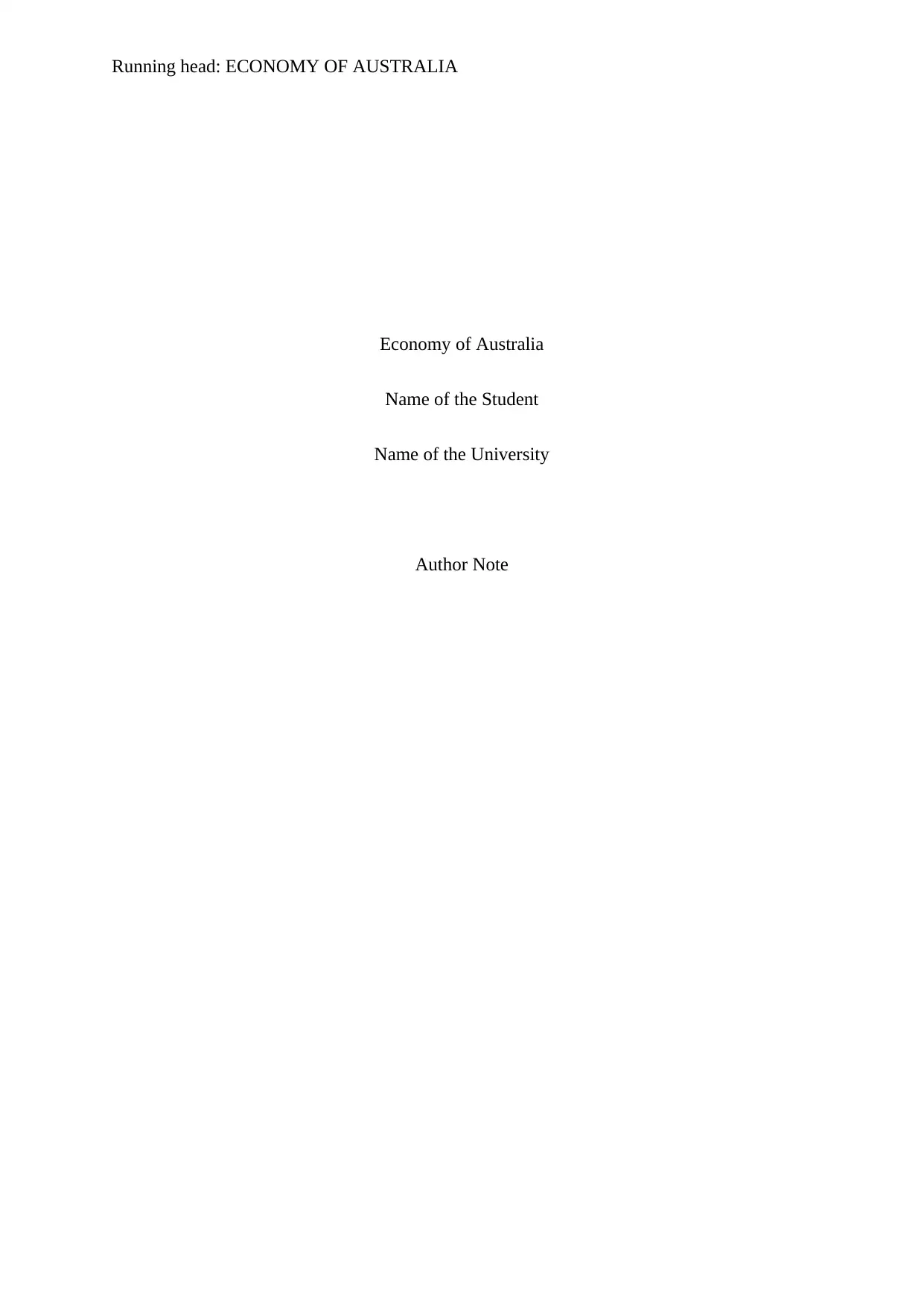
Running head: ECONOMY OF AUSTRALIA
Economy of Australia
Name of the Student
Name of the University
Author Note
Economy of Australia
Name of the Student
Name of the University
Author Note
Secure Best Marks with AI Grader
Need help grading? Try our AI Grader for instant feedback on your assignments.

1ECONOMY OF AUSTRALIA
Table of Contents
Introduction................................................................................................................................2
Australian economy in the last five years..................................................................................3
GDP growth trends in Australia.............................................................................................3
Demand and consumer’s welfare in Australia, 2012-2017....................................................6
Inflation rate in Australia, 2012-2017....................................................................................7
Unemployment in Australia, 2012-2017................................................................................8
Trade volumes in Australia, 2012-2017.................................................................................9
Economic policy structure of Australia....................................................................................10
Industrial dynamics in Australia..............................................................................................12
Reasons behind the sectoral shift.........................................................................................13
Conclusion................................................................................................................................14
References................................................................................................................................15
Table of Contents
Introduction................................................................................................................................2
Australian economy in the last five years..................................................................................3
GDP growth trends in Australia.............................................................................................3
Demand and consumer’s welfare in Australia, 2012-2017....................................................6
Inflation rate in Australia, 2012-2017....................................................................................7
Unemployment in Australia, 2012-2017................................................................................8
Trade volumes in Australia, 2012-2017.................................................................................9
Economic policy structure of Australia....................................................................................10
Industrial dynamics in Australia..............................................................................................12
Reasons behind the sectoral shift.........................................................................................13
Conclusion................................................................................................................................14
References................................................................................................................................15

2ECONOMY OF AUSTRALIA
Introduction
The global economy has over the years experienced huge changes and modifications
due to the changes in the economic traits of different countries as well as that of the globe
itself. Different countries have emerged as leading economies in the global framework at
different points of time, performing significantly well in all aspects of the economy.
However, there are several economies, which have over the decades remained as globally
dominant ones due to their impressive and sustained growth and overall economic
development and increased welfare of the residents of the countries (Lenzen et al. 2012). One
of such consistently dominant and influential economies, in the global framework, is that of
the economy of Australia.
The economy of Australia, has been showing consistent development and economic
prosperity over the decades, thereby emerging and remaining as one of the significantly
developed economies in the global framework. The economy, being one of the most stable
economies across the world, is known for its highly developed industrial sectors, employment
generation, trade openness and expansion as well as several booms in mining, residential and
commercial as well as banking sectors of the country (Dyster and Meredith 2012). The
prosperity of the economy can be seen from the performance of the different macroeconomic
indicators of the country over the years.
The economy of the country has however been subjected to considerable fluctuations,
over the last few years, due to both internal as well as external factors. Keeping this into
account the concerned report tries to analyse the dynamics in the GDP and overall economic
growth in Australia in the last five years, thereby discussing the policy frameworks present
and contributing to the same. Lastly, the report tries to discuss the nature of the industrial
growth in the concerned economy in the last five years.
Introduction
The global economy has over the years experienced huge changes and modifications
due to the changes in the economic traits of different countries as well as that of the globe
itself. Different countries have emerged as leading economies in the global framework at
different points of time, performing significantly well in all aspects of the economy.
However, there are several economies, which have over the decades remained as globally
dominant ones due to their impressive and sustained growth and overall economic
development and increased welfare of the residents of the countries (Lenzen et al. 2012). One
of such consistently dominant and influential economies, in the global framework, is that of
the economy of Australia.
The economy of Australia, has been showing consistent development and economic
prosperity over the decades, thereby emerging and remaining as one of the significantly
developed economies in the global framework. The economy, being one of the most stable
economies across the world, is known for its highly developed industrial sectors, employment
generation, trade openness and expansion as well as several booms in mining, residential and
commercial as well as banking sectors of the country (Dyster and Meredith 2012). The
prosperity of the economy can be seen from the performance of the different macroeconomic
indicators of the country over the years.
The economy of the country has however been subjected to considerable fluctuations,
over the last few years, due to both internal as well as external factors. Keeping this into
account the concerned report tries to analyse the dynamics in the GDP and overall economic
growth in Australia in the last five years, thereby discussing the policy frameworks present
and contributing to the same. Lastly, the report tries to discuss the nature of the industrial
growth in the concerned economy in the last five years.
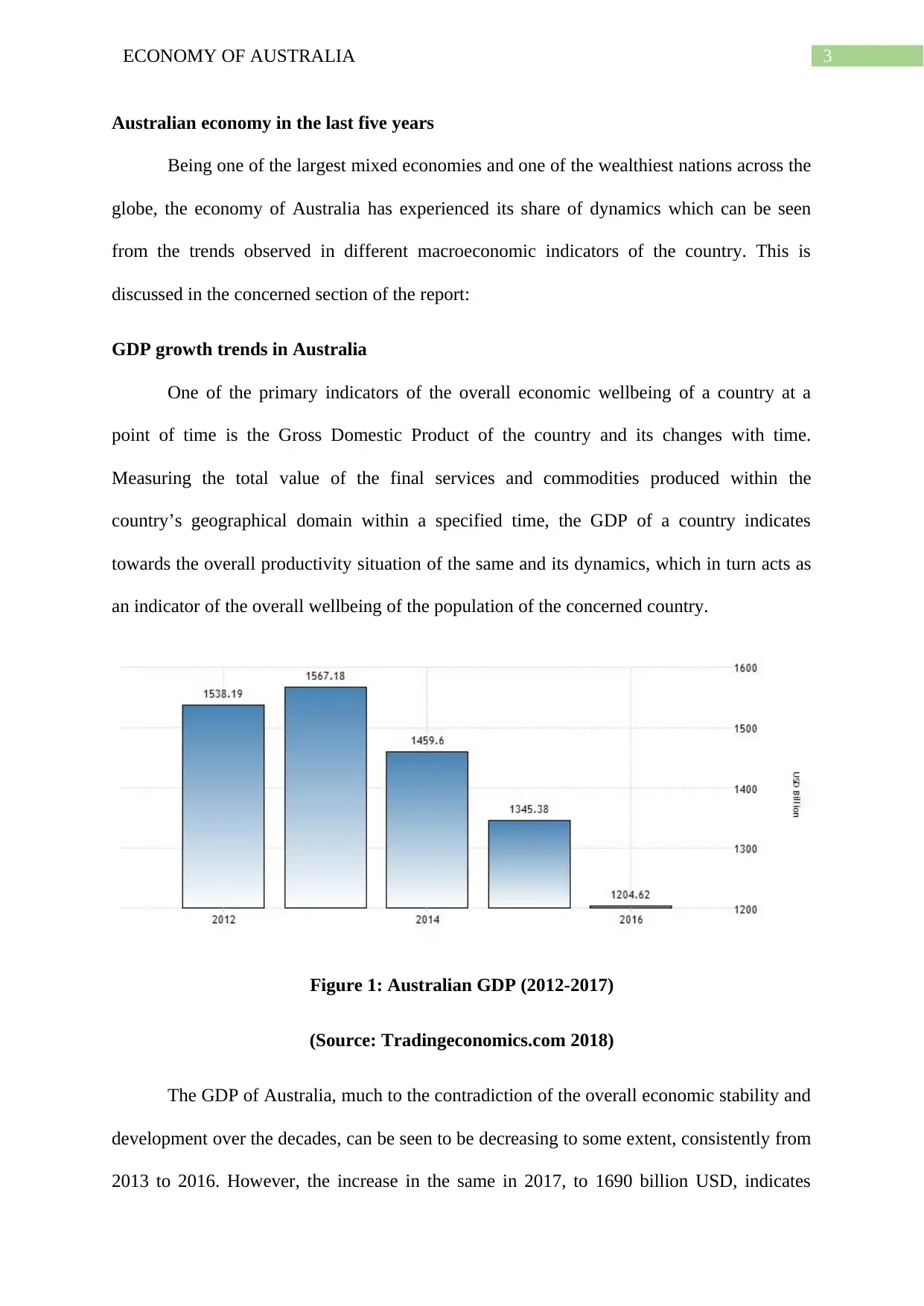
3ECONOMY OF AUSTRALIA
Australian economy in the last five years
Being one of the largest mixed economies and one of the wealthiest nations across the
globe, the economy of Australia has experienced its share of dynamics which can be seen
from the trends observed in different macroeconomic indicators of the country. This is
discussed in the concerned section of the report:
GDP growth trends in Australia
One of the primary indicators of the overall economic wellbeing of a country at a
point of time is the Gross Domestic Product of the country and its changes with time.
Measuring the total value of the final services and commodities produced within the
country’s geographical domain within a specified time, the GDP of a country indicates
towards the overall productivity situation of the same and its dynamics, which in turn acts as
an indicator of the overall wellbeing of the population of the concerned country.
Figure 1: Australian GDP (2012-2017)
(Source: Tradingeconomics.com 2018)
The GDP of Australia, much to the contradiction of the overall economic stability and
development over the decades, can be seen to be decreasing to some extent, consistently from
2013 to 2016. However, the increase in the same in 2017, to 1690 billion USD, indicates
Australian economy in the last five years
Being one of the largest mixed economies and one of the wealthiest nations across the
globe, the economy of Australia has experienced its share of dynamics which can be seen
from the trends observed in different macroeconomic indicators of the country. This is
discussed in the concerned section of the report:
GDP growth trends in Australia
One of the primary indicators of the overall economic wellbeing of a country at a
point of time is the Gross Domestic Product of the country and its changes with time.
Measuring the total value of the final services and commodities produced within the
country’s geographical domain within a specified time, the GDP of a country indicates
towards the overall productivity situation of the same and its dynamics, which in turn acts as
an indicator of the overall wellbeing of the population of the concerned country.
Figure 1: Australian GDP (2012-2017)
(Source: Tradingeconomics.com 2018)
The GDP of Australia, much to the contradiction of the overall economic stability and
development over the decades, can be seen to be decreasing to some extent, consistently from
2013 to 2016. However, the increase in the same in 2017, to 1690 billion USD, indicates
Secure Best Marks with AI Grader
Need help grading? Try our AI Grader for instant feedback on your assignments.
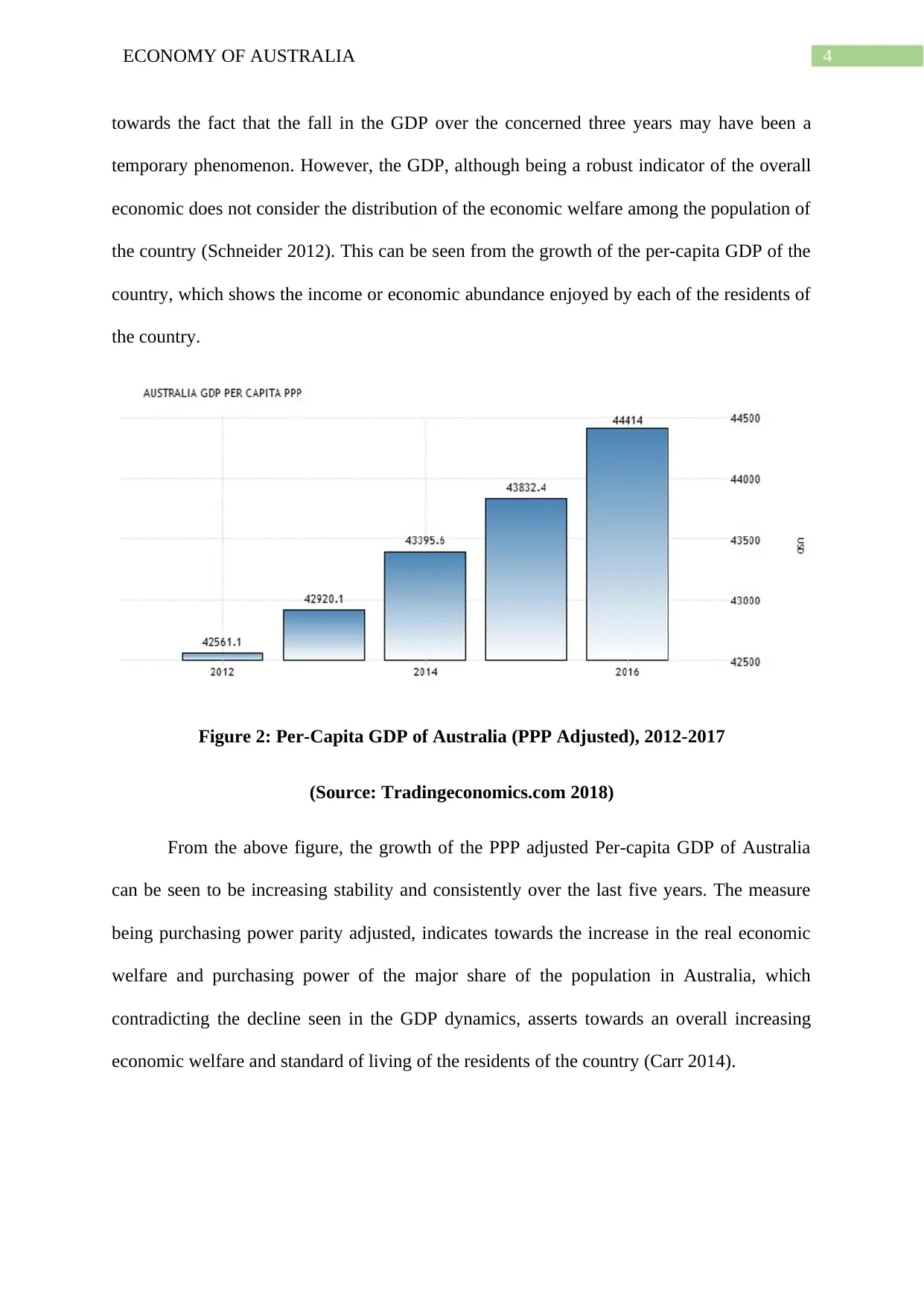
4ECONOMY OF AUSTRALIA
towards the fact that the fall in the GDP over the concerned three years may have been a
temporary phenomenon. However, the GDP, although being a robust indicator of the overall
economic does not consider the distribution of the economic welfare among the population of
the country (Schneider 2012). This can be seen from the growth of the per-capita GDP of the
country, which shows the income or economic abundance enjoyed by each of the residents of
the country.
Figure 2: Per-Capita GDP of Australia (PPP Adjusted), 2012-2017
(Source: Tradingeconomics.com 2018)
From the above figure, the growth of the PPP adjusted Per-capita GDP of Australia
can be seen to be increasing stability and consistently over the last five years. The measure
being purchasing power parity adjusted, indicates towards the increase in the real economic
welfare and purchasing power of the major share of the population in Australia, which
contradicting the decline seen in the GDP dynamics, asserts towards an overall increasing
economic welfare and standard of living of the residents of the country (Carr 2014).
towards the fact that the fall in the GDP over the concerned three years may have been a
temporary phenomenon. However, the GDP, although being a robust indicator of the overall
economic does not consider the distribution of the economic welfare among the population of
the country (Schneider 2012). This can be seen from the growth of the per-capita GDP of the
country, which shows the income or economic abundance enjoyed by each of the residents of
the country.
Figure 2: Per-Capita GDP of Australia (PPP Adjusted), 2012-2017
(Source: Tradingeconomics.com 2018)
From the above figure, the growth of the PPP adjusted Per-capita GDP of Australia
can be seen to be increasing stability and consistently over the last five years. The measure
being purchasing power parity adjusted, indicates towards the increase in the real economic
welfare and purchasing power of the major share of the population in Australia, which
contradicting the decline seen in the GDP dynamics, asserts towards an overall increasing
economic welfare and standard of living of the residents of the country (Carr 2014).
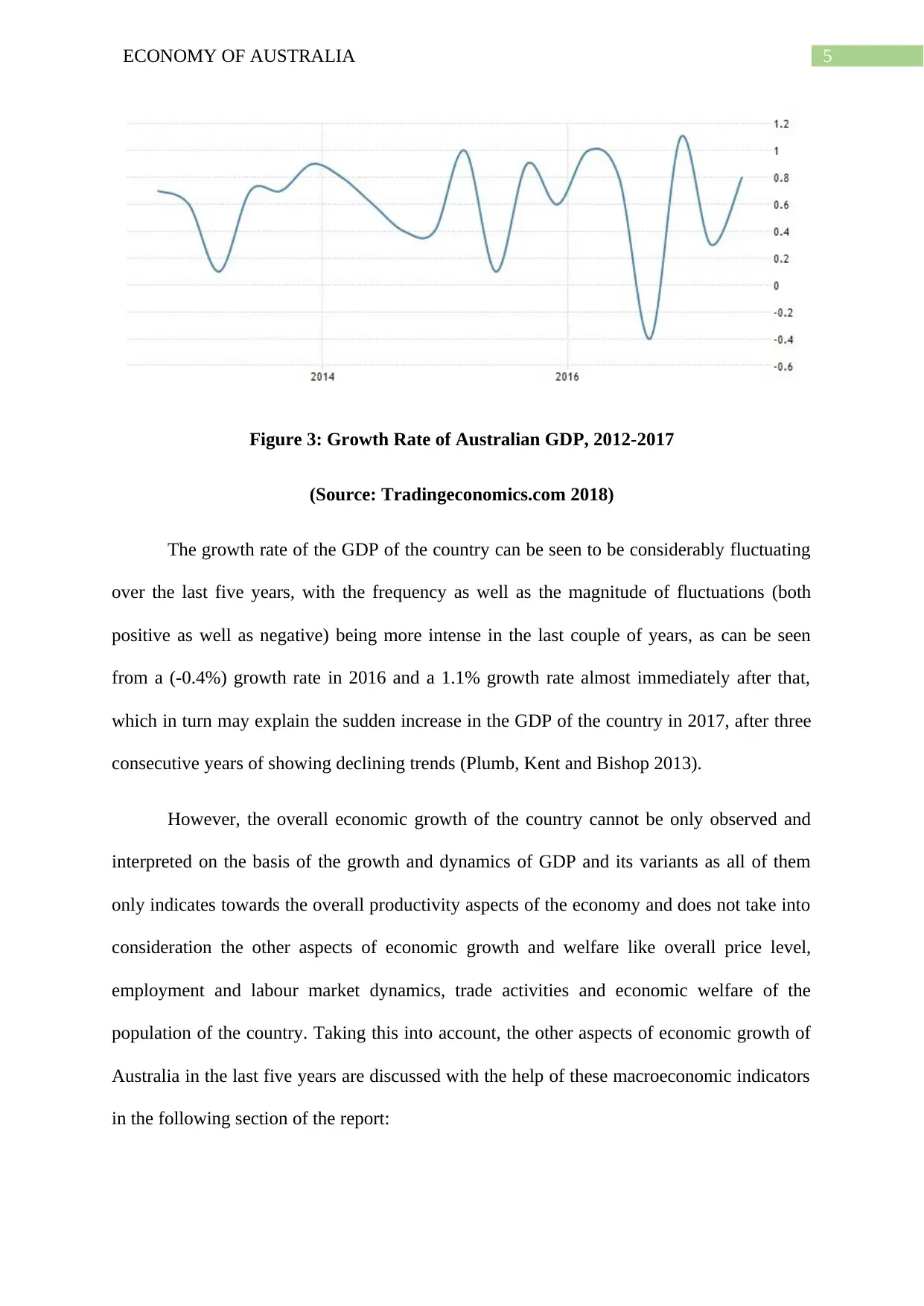
5ECONOMY OF AUSTRALIA
Figure 3: Growth Rate of Australian GDP, 2012-2017
(Source: Tradingeconomics.com 2018)
The growth rate of the GDP of the country can be seen to be considerably fluctuating
over the last five years, with the frequency as well as the magnitude of fluctuations (both
positive as well as negative) being more intense in the last couple of years, as can be seen
from a (-0.4%) growth rate in 2016 and a 1.1% growth rate almost immediately after that,
which in turn may explain the sudden increase in the GDP of the country in 2017, after three
consecutive years of showing declining trends (Plumb, Kent and Bishop 2013).
However, the overall economic growth of the country cannot be only observed and
interpreted on the basis of the growth and dynamics of GDP and its variants as all of them
only indicates towards the overall productivity aspects of the economy and does not take into
consideration the other aspects of economic growth and welfare like overall price level,
employment and labour market dynamics, trade activities and economic welfare of the
population of the country. Taking this into account, the other aspects of economic growth of
Australia in the last five years are discussed with the help of these macroeconomic indicators
in the following section of the report:
Figure 3: Growth Rate of Australian GDP, 2012-2017
(Source: Tradingeconomics.com 2018)
The growth rate of the GDP of the country can be seen to be considerably fluctuating
over the last five years, with the frequency as well as the magnitude of fluctuations (both
positive as well as negative) being more intense in the last couple of years, as can be seen
from a (-0.4%) growth rate in 2016 and a 1.1% growth rate almost immediately after that,
which in turn may explain the sudden increase in the GDP of the country in 2017, after three
consecutive years of showing declining trends (Plumb, Kent and Bishop 2013).
However, the overall economic growth of the country cannot be only observed and
interpreted on the basis of the growth and dynamics of GDP and its variants as all of them
only indicates towards the overall productivity aspects of the economy and does not take into
consideration the other aspects of economic growth and welfare like overall price level,
employment and labour market dynamics, trade activities and economic welfare of the
population of the country. Taking this into account, the other aspects of economic growth of
Australia in the last five years are discussed with the help of these macroeconomic indicators
in the following section of the report:
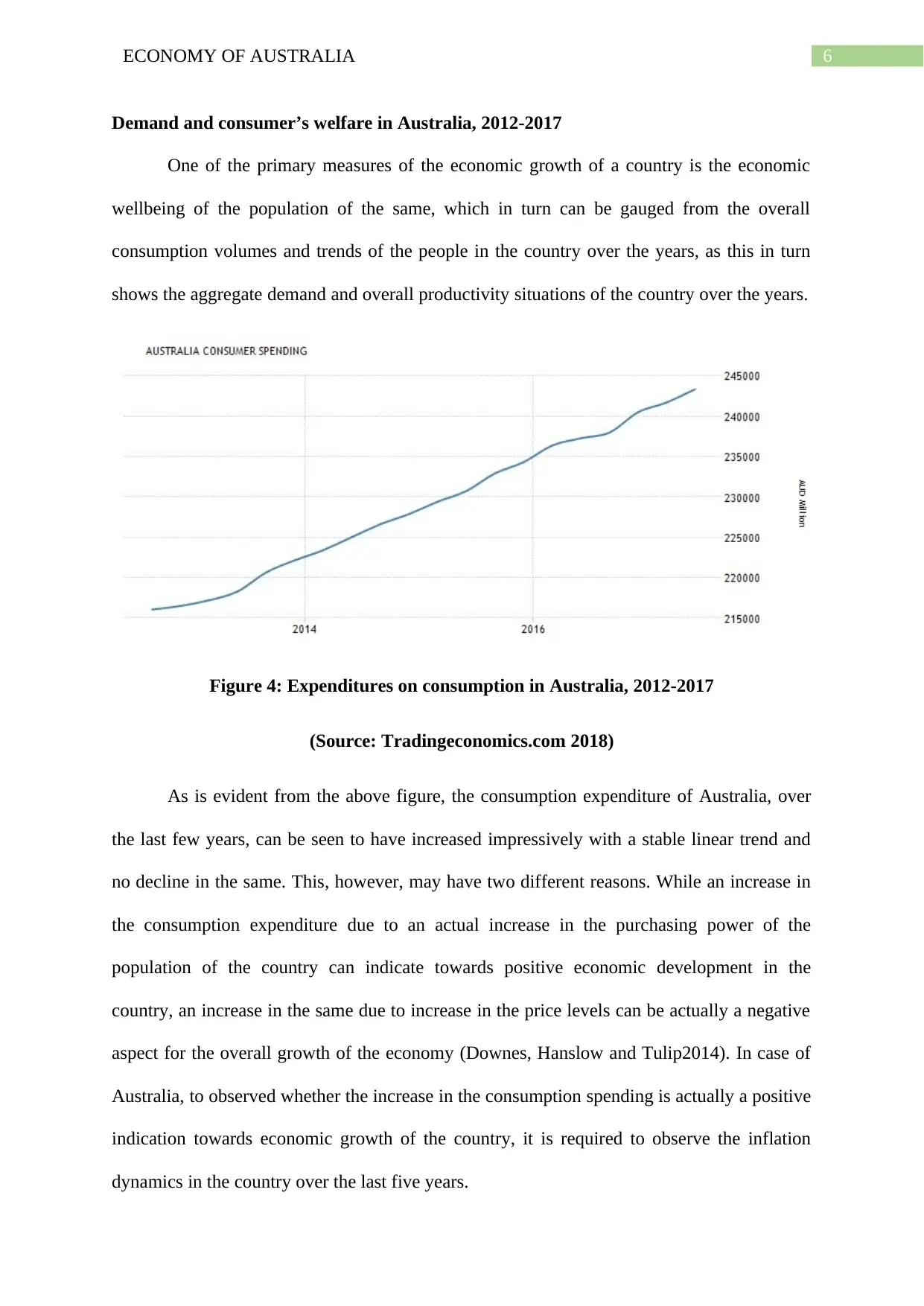
6ECONOMY OF AUSTRALIA
Demand and consumer’s welfare in Australia, 2012-2017
One of the primary measures of the economic growth of a country is the economic
wellbeing of the population of the same, which in turn can be gauged from the overall
consumption volumes and trends of the people in the country over the years, as this in turn
shows the aggregate demand and overall productivity situations of the country over the years.
Figure 4: Expenditures on consumption in Australia, 2012-2017
(Source: Tradingeconomics.com 2018)
As is evident from the above figure, the consumption expenditure of Australia, over
the last few years, can be seen to have increased impressively with a stable linear trend and
no decline in the same. This, however, may have two different reasons. While an increase in
the consumption expenditure due to an actual increase in the purchasing power of the
population of the country can indicate towards positive economic development in the
country, an increase in the same due to increase in the price levels can be actually a negative
aspect for the overall growth of the economy (Downes, Hanslow and Tulip2014). In case of
Australia, to observed whether the increase in the consumption spending is actually a positive
indication towards economic growth of the country, it is required to observe the inflation
dynamics in the country over the last five years.
Demand and consumer’s welfare in Australia, 2012-2017
One of the primary measures of the economic growth of a country is the economic
wellbeing of the population of the same, which in turn can be gauged from the overall
consumption volumes and trends of the people in the country over the years, as this in turn
shows the aggregate demand and overall productivity situations of the country over the years.
Figure 4: Expenditures on consumption in Australia, 2012-2017
(Source: Tradingeconomics.com 2018)
As is evident from the above figure, the consumption expenditure of Australia, over
the last few years, can be seen to have increased impressively with a stable linear trend and
no decline in the same. This, however, may have two different reasons. While an increase in
the consumption expenditure due to an actual increase in the purchasing power of the
population of the country can indicate towards positive economic development in the
country, an increase in the same due to increase in the price levels can be actually a negative
aspect for the overall growth of the economy (Downes, Hanslow and Tulip2014). In case of
Australia, to observed whether the increase in the consumption spending is actually a positive
indication towards economic growth of the country, it is required to observe the inflation
dynamics in the country over the last five years.
Paraphrase This Document
Need a fresh take? Get an instant paraphrase of this document with our AI Paraphraser
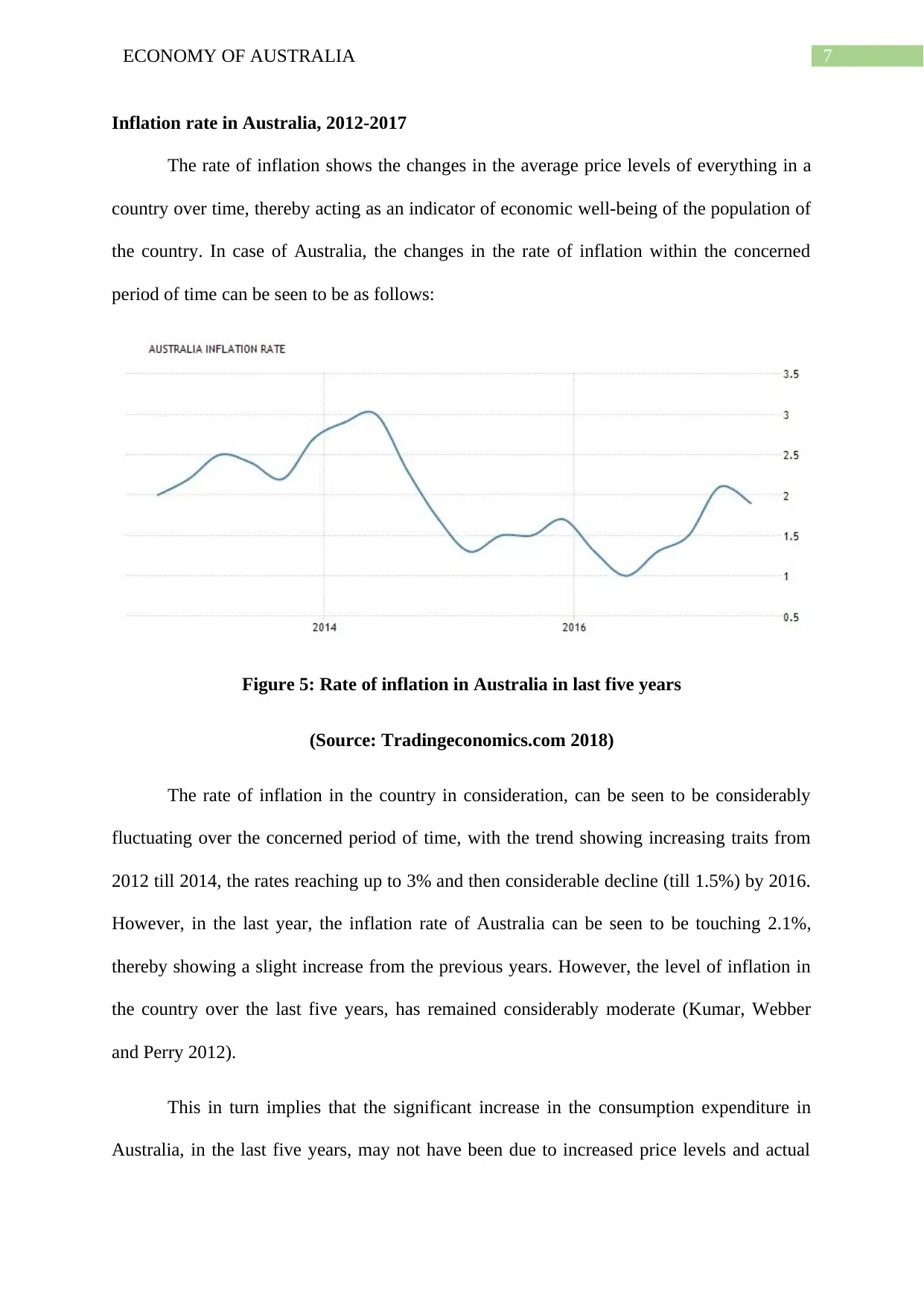
7ECONOMY OF AUSTRALIA
Inflation rate in Australia, 2012-2017
The rate of inflation shows the changes in the average price levels of everything in a
country over time, thereby acting as an indicator of economic well-being of the population of
the country. In case of Australia, the changes in the rate of inflation within the concerned
period of time can be seen to be as follows:
Figure 5: Rate of inflation in Australia in last five years
(Source: Tradingeconomics.com 2018)
The rate of inflation in the country in consideration, can be seen to be considerably
fluctuating over the concerned period of time, with the trend showing increasing traits from
2012 till 2014, the rates reaching up to 3% and then considerable decline (till 1.5%) by 2016.
However, in the last year, the inflation rate of Australia can be seen to be touching 2.1%,
thereby showing a slight increase from the previous years. However, the level of inflation in
the country over the last five years, has remained considerably moderate (Kumar, Webber
and Perry 2012).
This in turn implies that the significant increase in the consumption expenditure in
Australia, in the last five years, may not have been due to increased price levels and actual
Inflation rate in Australia, 2012-2017
The rate of inflation shows the changes in the average price levels of everything in a
country over time, thereby acting as an indicator of economic well-being of the population of
the country. In case of Australia, the changes in the rate of inflation within the concerned
period of time can be seen to be as follows:
Figure 5: Rate of inflation in Australia in last five years
(Source: Tradingeconomics.com 2018)
The rate of inflation in the country in consideration, can be seen to be considerably
fluctuating over the concerned period of time, with the trend showing increasing traits from
2012 till 2014, the rates reaching up to 3% and then considerable decline (till 1.5%) by 2016.
However, in the last year, the inflation rate of Australia can be seen to be touching 2.1%,
thereby showing a slight increase from the previous years. However, the level of inflation in
the country over the last five years, has remained considerably moderate (Kumar, Webber
and Perry 2012).
This in turn implies that the significant increase in the consumption expenditure in
Australia, in the last five years, may not have been due to increased price levels and actual
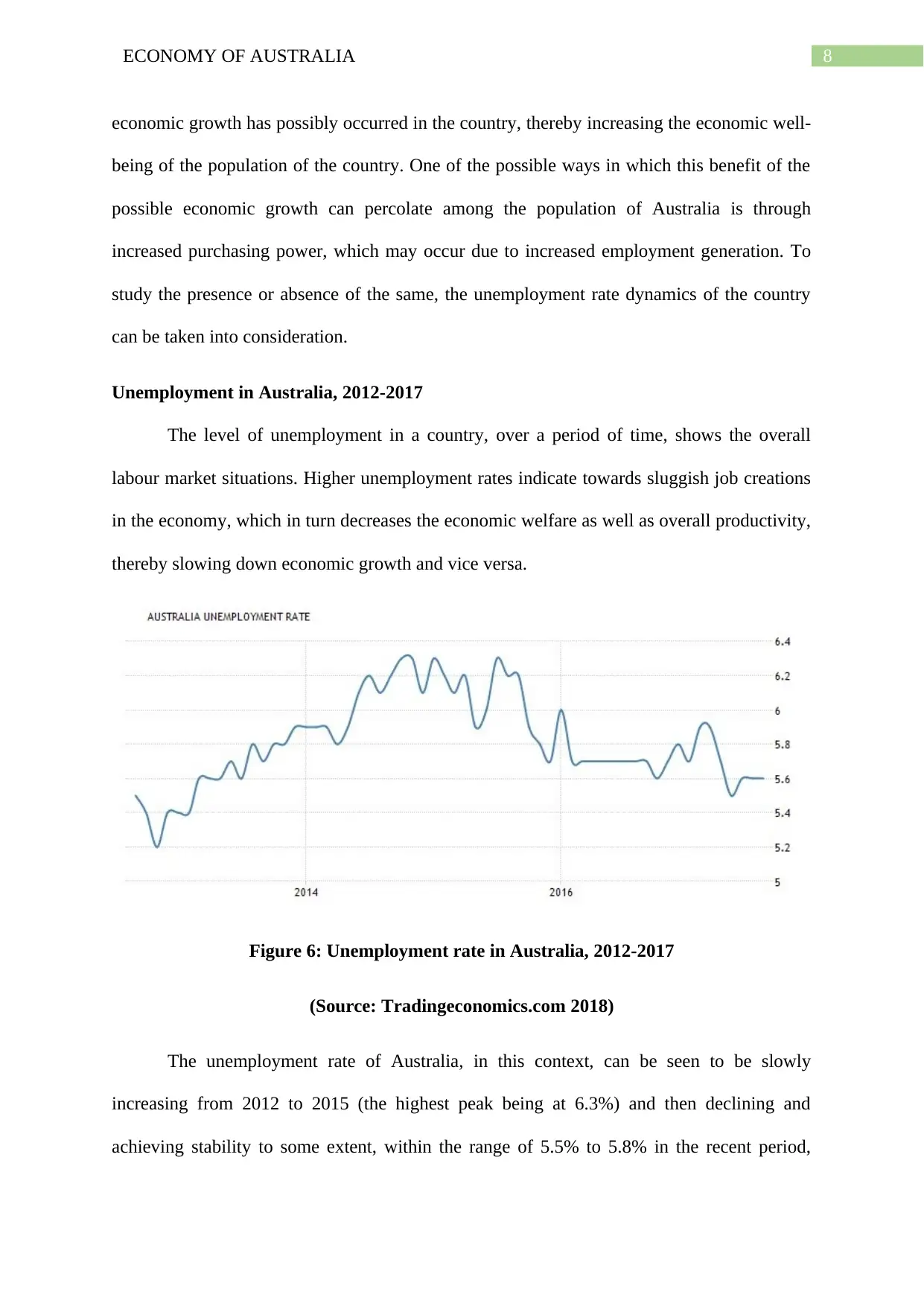
8ECONOMY OF AUSTRALIA
economic growth has possibly occurred in the country, thereby increasing the economic well-
being of the population of the country. One of the possible ways in which this benefit of the
possible economic growth can percolate among the population of Australia is through
increased purchasing power, which may occur due to increased employment generation. To
study the presence or absence of the same, the unemployment rate dynamics of the country
can be taken into consideration.
Unemployment in Australia, 2012-2017
The level of unemployment in a country, over a period of time, shows the overall
labour market situations. Higher unemployment rates indicate towards sluggish job creations
in the economy, which in turn decreases the economic welfare as well as overall productivity,
thereby slowing down economic growth and vice versa.
Figure 6: Unemployment rate in Australia, 2012-2017
(Source: Tradingeconomics.com 2018)
The unemployment rate of Australia, in this context, can be seen to be slowly
increasing from 2012 to 2015 (the highest peak being at 6.3%) and then declining and
achieving stability to some extent, within the range of 5.5% to 5.8% in the recent period,
economic growth has possibly occurred in the country, thereby increasing the economic well-
being of the population of the country. One of the possible ways in which this benefit of the
possible economic growth can percolate among the population of Australia is through
increased purchasing power, which may occur due to increased employment generation. To
study the presence or absence of the same, the unemployment rate dynamics of the country
can be taken into consideration.
Unemployment in Australia, 2012-2017
The level of unemployment in a country, over a period of time, shows the overall
labour market situations. Higher unemployment rates indicate towards sluggish job creations
in the economy, which in turn decreases the economic welfare as well as overall productivity,
thereby slowing down economic growth and vice versa.
Figure 6: Unemployment rate in Australia, 2012-2017
(Source: Tradingeconomics.com 2018)
The unemployment rate of Australia, in this context, can be seen to be slowly
increasing from 2012 to 2015 (the highest peak being at 6.3%) and then declining and
achieving stability to some extent, within the range of 5.5% to 5.8% in the recent period,
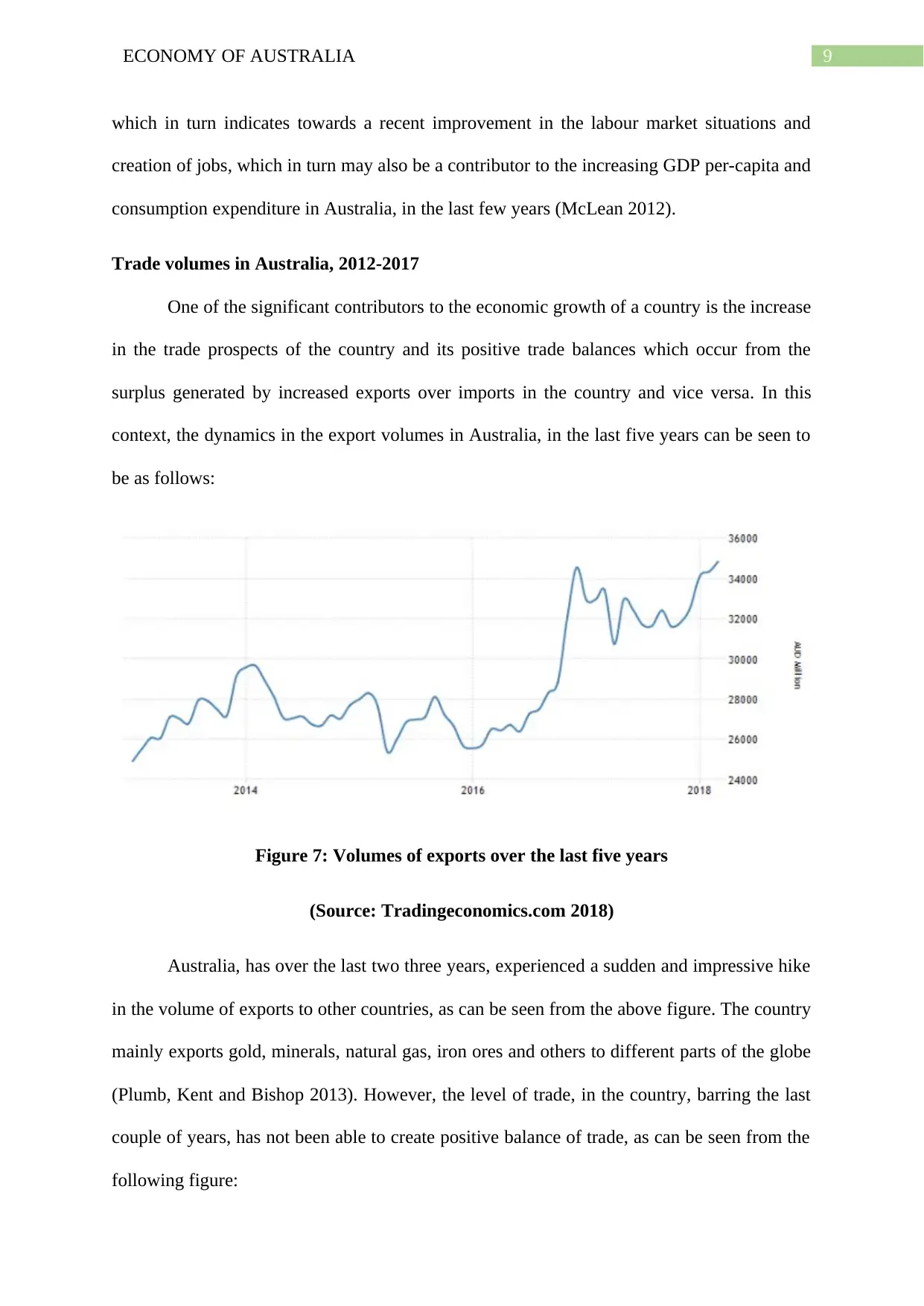
9ECONOMY OF AUSTRALIA
which in turn indicates towards a recent improvement in the labour market situations and
creation of jobs, which in turn may also be a contributor to the increasing GDP per-capita and
consumption expenditure in Australia, in the last few years (McLean 2012).
Trade volumes in Australia, 2012-2017
One of the significant contributors to the economic growth of a country is the increase
in the trade prospects of the country and its positive trade balances which occur from the
surplus generated by increased exports over imports in the country and vice versa. In this
context, the dynamics in the export volumes in Australia, in the last five years can be seen to
be as follows:
Figure 7: Volumes of exports over the last five years
(Source: Tradingeconomics.com 2018)
Australia, has over the last two three years, experienced a sudden and impressive hike
in the volume of exports to other countries, as can be seen from the above figure. The country
mainly exports gold, minerals, natural gas, iron ores and others to different parts of the globe
(Plumb, Kent and Bishop 2013). However, the level of trade, in the country, barring the last
couple of years, has not been able to create positive balance of trade, as can be seen from the
following figure:
which in turn indicates towards a recent improvement in the labour market situations and
creation of jobs, which in turn may also be a contributor to the increasing GDP per-capita and
consumption expenditure in Australia, in the last few years (McLean 2012).
Trade volumes in Australia, 2012-2017
One of the significant contributors to the economic growth of a country is the increase
in the trade prospects of the country and its positive trade balances which occur from the
surplus generated by increased exports over imports in the country and vice versa. In this
context, the dynamics in the export volumes in Australia, in the last five years can be seen to
be as follows:
Figure 7: Volumes of exports over the last five years
(Source: Tradingeconomics.com 2018)
Australia, has over the last two three years, experienced a sudden and impressive hike
in the volume of exports to other countries, as can be seen from the above figure. The country
mainly exports gold, minerals, natural gas, iron ores and others to different parts of the globe
(Plumb, Kent and Bishop 2013). However, the level of trade, in the country, barring the last
couple of years, has not been able to create positive balance of trade, as can be seen from the
following figure:
Secure Best Marks with AI Grader
Need help grading? Try our AI Grader for instant feedback on your assignments.
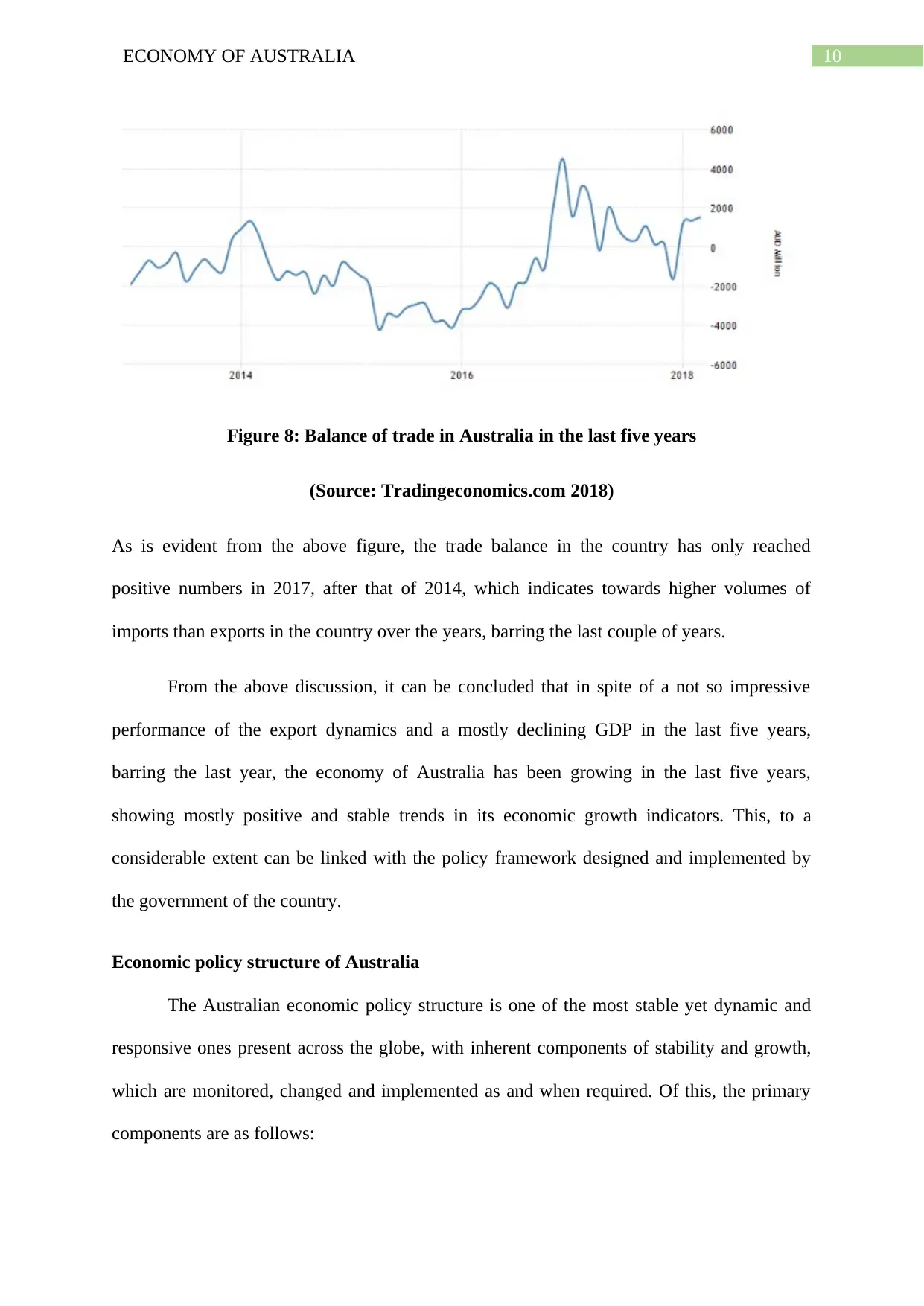
10ECONOMY OF AUSTRALIA
Figure 8: Balance of trade in Australia in the last five years
(Source: Tradingeconomics.com 2018)
As is evident from the above figure, the trade balance in the country has only reached
positive numbers in 2017, after that of 2014, which indicates towards higher volumes of
imports than exports in the country over the years, barring the last couple of years.
From the above discussion, it can be concluded that in spite of a not so impressive
performance of the export dynamics and a mostly declining GDP in the last five years,
barring the last year, the economy of Australia has been growing in the last five years,
showing mostly positive and stable trends in its economic growth indicators. This, to a
considerable extent can be linked with the policy framework designed and implemented by
the government of the country.
Economic policy structure of Australia
The Australian economic policy structure is one of the most stable yet dynamic and
responsive ones present across the globe, with inherent components of stability and growth,
which are monitored, changed and implemented as and when required. Of this, the primary
components are as follows:
Figure 8: Balance of trade in Australia in the last five years
(Source: Tradingeconomics.com 2018)
As is evident from the above figure, the trade balance in the country has only reached
positive numbers in 2017, after that of 2014, which indicates towards higher volumes of
imports than exports in the country over the years, barring the last couple of years.
From the above discussion, it can be concluded that in spite of a not so impressive
performance of the export dynamics and a mostly declining GDP in the last five years,
barring the last year, the economy of Australia has been growing in the last five years,
showing mostly positive and stable trends in its economic growth indicators. This, to a
considerable extent can be linked with the policy framework designed and implemented by
the government of the country.
Economic policy structure of Australia
The Australian economic policy structure is one of the most stable yet dynamic and
responsive ones present across the globe, with inherent components of stability and growth,
which are monitored, changed and implemented as and when required. Of this, the primary
components are as follows:

11ECONOMY OF AUSTRALIA
The primary component of the economic policy in the country is the priority
emphasized on achieving full employment in the economy over time. To reach this
goal, the government of the country has been implementing various policies like
Indigenous Employment policy, the National Employment Strategy and so on
(Kumar, Webber and Perry 2012). The government also provides unemployment
insurances and supports to the job seekers and different vocational training and skill
development programs with the objective of increasing the overall skill and
productivity of the labours in the economy.
The unique deficit exit strategy is one of the key components of the deficit financing
aspects of the country, in the domain of which the country does not encourage deficit
financing of more than 2% till surplus is generated.
The economic policy structure of the country also has various fiscal and monetary
stability stimuli which act as safety valves in case of any irregularities or turmoil in
the economy, as can be seen to have helped the economy during the time of economic
crisis of 2008-2009, when in spite of the presence of Global Financial Crisis,
Australia managed to recover soon without any significant long-term damages (Lowe
2012).
The economic policies of the country are pro-industrial and pro-commerce. Australia
has over the years attracted huge investments from all parts of the world and also has
set up robust trade relations with nearly all parts of the globe which has contributed in
the exemplary industrial growth of the country (Penrose 2017). The country is part of
several crucial international Free Trade Agreements with most of the other significant
economies across the globe.
The policy frameworks of the country, in spite of encouraging foreign companies and
people to come in and do business, tries to protect and support the growth of the
The primary component of the economic policy in the country is the priority
emphasized on achieving full employment in the economy over time. To reach this
goal, the government of the country has been implementing various policies like
Indigenous Employment policy, the National Employment Strategy and so on
(Kumar, Webber and Perry 2012). The government also provides unemployment
insurances and supports to the job seekers and different vocational training and skill
development programs with the objective of increasing the overall skill and
productivity of the labours in the economy.
The unique deficit exit strategy is one of the key components of the deficit financing
aspects of the country, in the domain of which the country does not encourage deficit
financing of more than 2% till surplus is generated.
The economic policy structure of the country also has various fiscal and monetary
stability stimuli which act as safety valves in case of any irregularities or turmoil in
the economy, as can be seen to have helped the economy during the time of economic
crisis of 2008-2009, when in spite of the presence of Global Financial Crisis,
Australia managed to recover soon without any significant long-term damages (Lowe
2012).
The economic policies of the country are pro-industrial and pro-commerce. Australia
has over the years attracted huge investments from all parts of the world and also has
set up robust trade relations with nearly all parts of the globe which has contributed in
the exemplary industrial growth of the country (Penrose 2017). The country is part of
several crucial international Free Trade Agreements with most of the other significant
economies across the globe.
The policy frameworks of the country, in spite of encouraging foreign companies and
people to come in and do business, tries to protect and support the growth of the
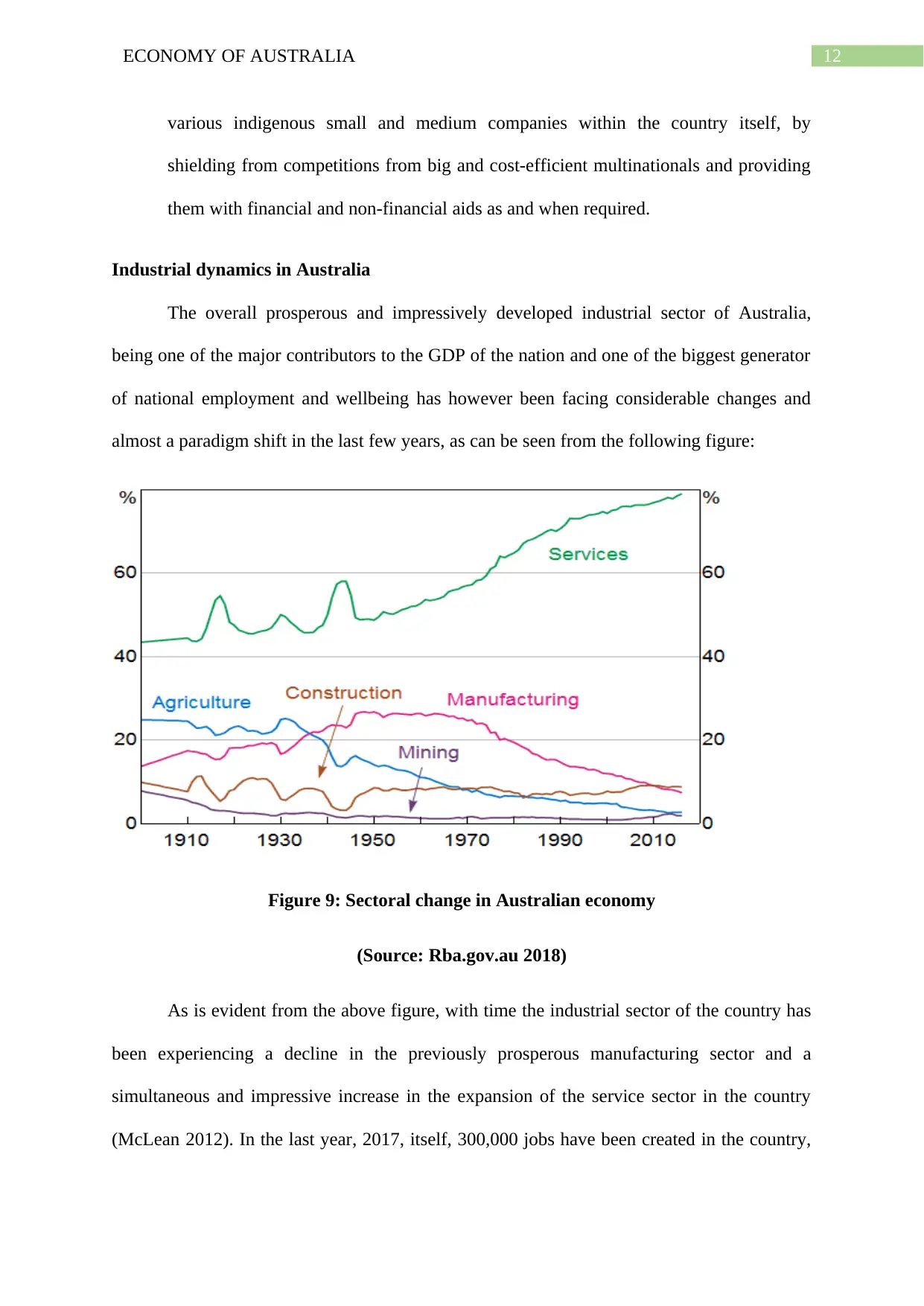
12ECONOMY OF AUSTRALIA
various indigenous small and medium companies within the country itself, by
shielding from competitions from big and cost-efficient multinationals and providing
them with financial and non-financial aids as and when required.
Industrial dynamics in Australia
The overall prosperous and impressively developed industrial sector of Australia,
being one of the major contributors to the GDP of the nation and one of the biggest generator
of national employment and wellbeing has however been facing considerable changes and
almost a paradigm shift in the last few years, as can be seen from the following figure:
Figure 9: Sectoral change in Australian economy
(Source: Rba.gov.au 2018)
As is evident from the above figure, with time the industrial sector of the country has
been experiencing a decline in the previously prosperous manufacturing sector and a
simultaneous and impressive increase in the expansion of the service sector in the country
(McLean 2012). In the last year, 2017, itself, 300,000 jobs have been created in the country,
various indigenous small and medium companies within the country itself, by
shielding from competitions from big and cost-efficient multinationals and providing
them with financial and non-financial aids as and when required.
Industrial dynamics in Australia
The overall prosperous and impressively developed industrial sector of Australia,
being one of the major contributors to the GDP of the nation and one of the biggest generator
of national employment and wellbeing has however been facing considerable changes and
almost a paradigm shift in the last few years, as can be seen from the following figure:
Figure 9: Sectoral change in Australian economy
(Source: Rba.gov.au 2018)
As is evident from the above figure, with time the industrial sector of the country has
been experiencing a decline in the previously prosperous manufacturing sector and a
simultaneous and impressive increase in the expansion of the service sector in the country
(McLean 2012). In the last year, 2017, itself, 300,000 jobs have been created in the country,
Paraphrase This Document
Need a fresh take? Get an instant paraphrase of this document with our AI Paraphraser
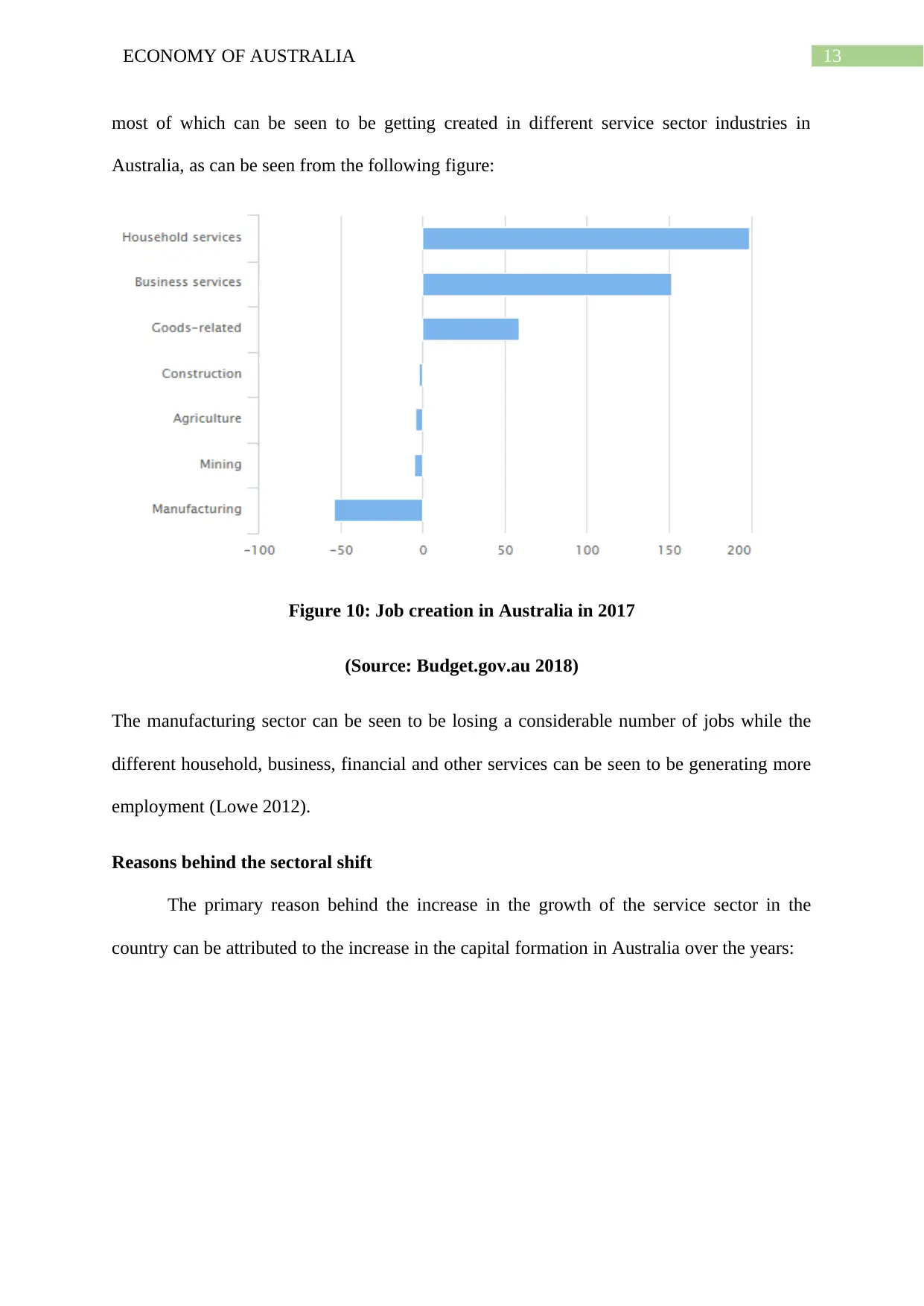
13ECONOMY OF AUSTRALIA
most of which can be seen to be getting created in different service sector industries in
Australia, as can be seen from the following figure:
Figure 10: Job creation in Australia in 2017
(Source: Budget.gov.au 2018)
The manufacturing sector can be seen to be losing a considerable number of jobs while the
different household, business, financial and other services can be seen to be generating more
employment (Lowe 2012).
Reasons behind the sectoral shift
The primary reason behind the increase in the growth of the service sector in the
country can be attributed to the increase in the capital formation in Australia over the years:
most of which can be seen to be getting created in different service sector industries in
Australia, as can be seen from the following figure:
Figure 10: Job creation in Australia in 2017
(Source: Budget.gov.au 2018)
The manufacturing sector can be seen to be losing a considerable number of jobs while the
different household, business, financial and other services can be seen to be generating more
employment (Lowe 2012).
Reasons behind the sectoral shift
The primary reason behind the increase in the growth of the service sector in the
country can be attributed to the increase in the capital formation in Australia over the years:
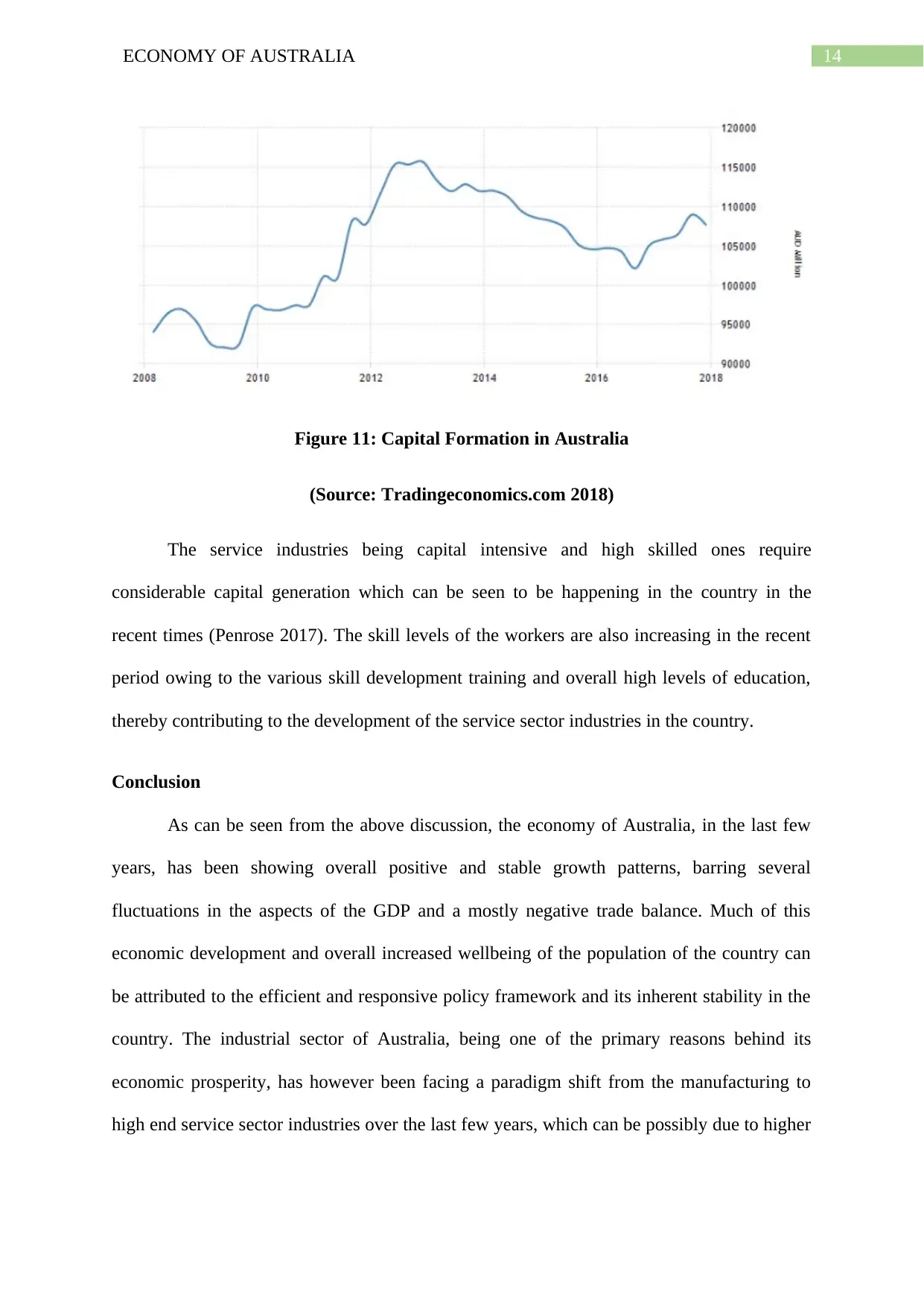
14ECONOMY OF AUSTRALIA
Figure 11: Capital Formation in Australia
(Source: Tradingeconomics.com 2018)
The service industries being capital intensive and high skilled ones require
considerable capital generation which can be seen to be happening in the country in the
recent times (Penrose 2017). The skill levels of the workers are also increasing in the recent
period owing to the various skill development training and overall high levels of education,
thereby contributing to the development of the service sector industries in the country.
Conclusion
As can be seen from the above discussion, the economy of Australia, in the last few
years, has been showing overall positive and stable growth patterns, barring several
fluctuations in the aspects of the GDP and a mostly negative trade balance. Much of this
economic development and overall increased wellbeing of the population of the country can
be attributed to the efficient and responsive policy framework and its inherent stability in the
country. The industrial sector of Australia, being one of the primary reasons behind its
economic prosperity, has however been facing a paradigm shift from the manufacturing to
high end service sector industries over the last few years, which can be possibly due to higher
Figure 11: Capital Formation in Australia
(Source: Tradingeconomics.com 2018)
The service industries being capital intensive and high skilled ones require
considerable capital generation which can be seen to be happening in the country in the
recent times (Penrose 2017). The skill levels of the workers are also increasing in the recent
period owing to the various skill development training and overall high levels of education,
thereby contributing to the development of the service sector industries in the country.
Conclusion
As can be seen from the above discussion, the economy of Australia, in the last few
years, has been showing overall positive and stable growth patterns, barring several
fluctuations in the aspects of the GDP and a mostly negative trade balance. Much of this
economic development and overall increased wellbeing of the population of the country can
be attributed to the efficient and responsive policy framework and its inherent stability in the
country. The industrial sector of Australia, being one of the primary reasons behind its
economic prosperity, has however been facing a paradigm shift from the manufacturing to
high end service sector industries over the last few years, which can be possibly due to higher

15ECONOMY OF AUSTRALIA
capital formation and development of skill of the labours in the country in a generalised
framework.
References
Tradingeconomics.com (2018). Australia Balance of Trade | 1971-2018 | Data | Chart |
Calendar | Forecast. [online] Tradingeconomics.com. Available at:
https://tradingeconomics.com/australia/balance-of-trade [Accessed 24 May 2018].
Tradingeconomics.com (2018). Australia Exports | 1971-2018 | Data | Chart | Calendar |
Forecast | News. [online] Tradingeconomics.com. Available at:
https://tradingeconomics.com/australia/exports [Accessed 24 May 2018].
Tradingeconomics.com (2018). Australia GDP | 1960-2018 | Data | Chart | Calendar |
Forecast | News. [online] Tradingeconomics.com. Available at:
https://tradingeconomics.com/australia/gdp [Accessed 24 May 2018].
Tradingeconomics.com (2018). Australia GDP per capita PPP | 1990-2018 | Data | Chart |
Calendar. [online] Tradingeconomics.com. Available at:
https://tradingeconomics.com/australia/gdp-per-capita-ppp [Accessed 24 May 2018].
Tradingeconomics.com (2018). Australia Inflation Rate | 1951-2018 | Data | Chart |
Calendar | Forecast. [online] Tradingeconomics.com. Available at:
https://tradingeconomics.com/australia/inflation-cpi [Accessed 24 May 2018].
Tradingeconomics.com (2018). Australia Gross Fixed Capital Formation | 1959-2018 | Data
| Chart. [online] Tradingeconomics.com. Available at:
https://tradingeconomics.com/australia/gross-fixed-capital-formation [Accessed 24 May
2018].
capital formation and development of skill of the labours in the country in a generalised
framework.
References
Tradingeconomics.com (2018). Australia Balance of Trade | 1971-2018 | Data | Chart |
Calendar | Forecast. [online] Tradingeconomics.com. Available at:
https://tradingeconomics.com/australia/balance-of-trade [Accessed 24 May 2018].
Tradingeconomics.com (2018). Australia Exports | 1971-2018 | Data | Chart | Calendar |
Forecast | News. [online] Tradingeconomics.com. Available at:
https://tradingeconomics.com/australia/exports [Accessed 24 May 2018].
Tradingeconomics.com (2018). Australia GDP | 1960-2018 | Data | Chart | Calendar |
Forecast | News. [online] Tradingeconomics.com. Available at:
https://tradingeconomics.com/australia/gdp [Accessed 24 May 2018].
Tradingeconomics.com (2018). Australia GDP per capita PPP | 1990-2018 | Data | Chart |
Calendar. [online] Tradingeconomics.com. Available at:
https://tradingeconomics.com/australia/gdp-per-capita-ppp [Accessed 24 May 2018].
Tradingeconomics.com (2018). Australia Inflation Rate | 1951-2018 | Data | Chart |
Calendar | Forecast. [online] Tradingeconomics.com. Available at:
https://tradingeconomics.com/australia/inflation-cpi [Accessed 24 May 2018].
Tradingeconomics.com (2018). Australia Gross Fixed Capital Formation | 1959-2018 | Data
| Chart. [online] Tradingeconomics.com. Available at:
https://tradingeconomics.com/australia/gross-fixed-capital-formation [Accessed 24 May
2018].
Secure Best Marks with AI Grader
Need help grading? Try our AI Grader for instant feedback on your assignments.
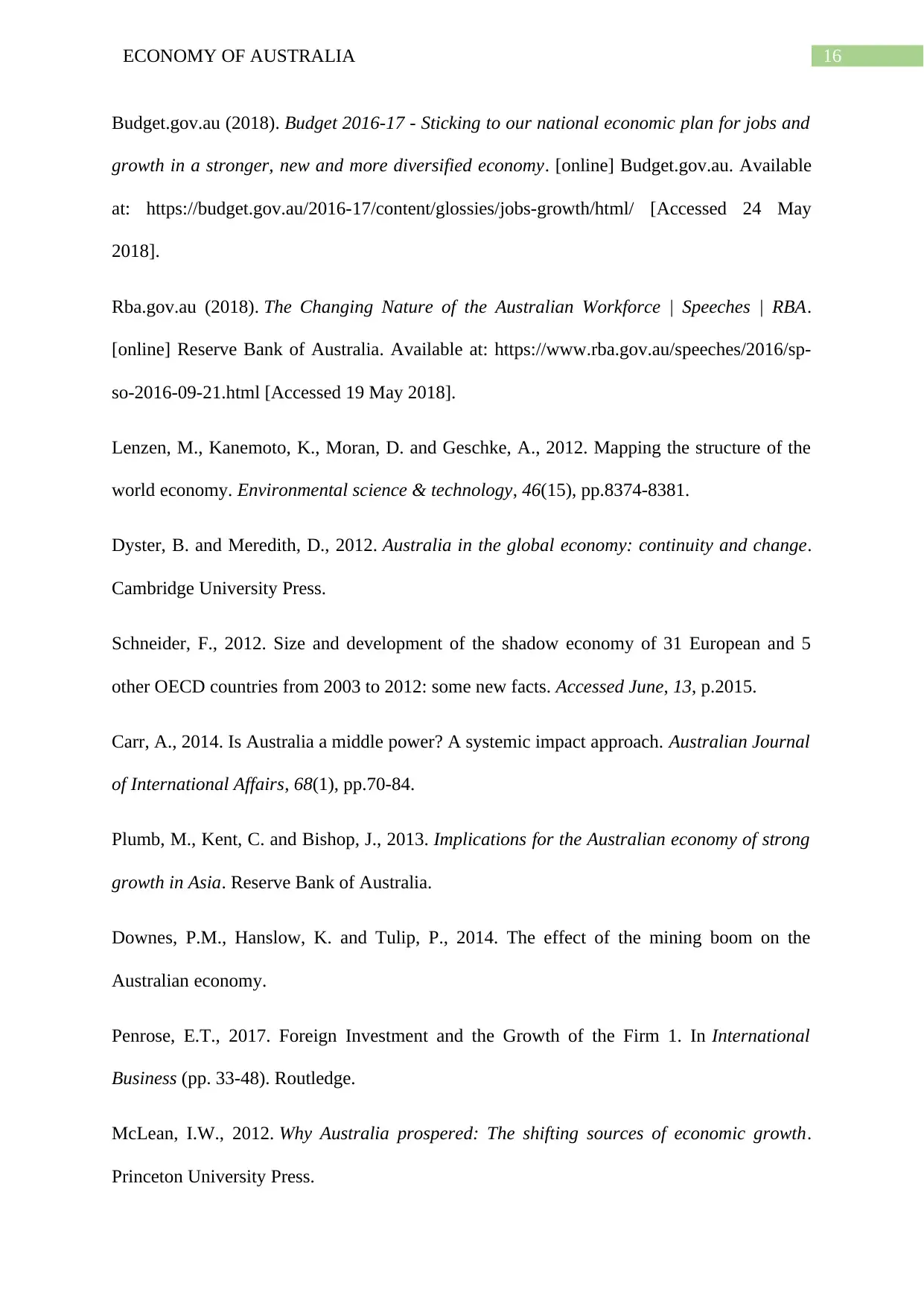
16ECONOMY OF AUSTRALIA
Budget.gov.au (2018). Budget 2016-17 - Sticking to our national economic plan for jobs and
growth in a stronger, new and more diversified economy. [online] Budget.gov.au. Available
at: https://budget.gov.au/2016-17/content/glossies/jobs-growth/html/ [Accessed 24 May
2018].
Rba.gov.au (2018). The Changing Nature of the Australian Workforce | Speeches | RBA.
[online] Reserve Bank of Australia. Available at: https://www.rba.gov.au/speeches/2016/sp-
so-2016-09-21.html [Accessed 19 May 2018].
Lenzen, M., Kanemoto, K., Moran, D. and Geschke, A., 2012. Mapping the structure of the
world economy. Environmental science & technology, 46(15), pp.8374-8381.
Dyster, B. and Meredith, D., 2012. Australia in the global economy: continuity and change.
Cambridge University Press.
Schneider, F., 2012. Size and development of the shadow economy of 31 European and 5
other OECD countries from 2003 to 2012: some new facts. Accessed June, 13, p.2015.
Carr, A., 2014. Is Australia a middle power? A systemic impact approach. Australian Journal
of International Affairs, 68(1), pp.70-84.
Plumb, M., Kent, C. and Bishop, J., 2013. Implications for the Australian economy of strong
growth in Asia. Reserve Bank of Australia.
Downes, P.M., Hanslow, K. and Tulip, P., 2014. The effect of the mining boom on the
Australian economy.
Penrose, E.T., 2017. Foreign Investment and the Growth of the Firm 1. In International
Business (pp. 33-48). Routledge.
McLean, I.W., 2012. Why Australia prospered: The shifting sources of economic growth.
Princeton University Press.
Budget.gov.au (2018). Budget 2016-17 - Sticking to our national economic plan for jobs and
growth in a stronger, new and more diversified economy. [online] Budget.gov.au. Available
at: https://budget.gov.au/2016-17/content/glossies/jobs-growth/html/ [Accessed 24 May
2018].
Rba.gov.au (2018). The Changing Nature of the Australian Workforce | Speeches | RBA.
[online] Reserve Bank of Australia. Available at: https://www.rba.gov.au/speeches/2016/sp-
so-2016-09-21.html [Accessed 19 May 2018].
Lenzen, M., Kanemoto, K., Moran, D. and Geschke, A., 2012. Mapping the structure of the
world economy. Environmental science & technology, 46(15), pp.8374-8381.
Dyster, B. and Meredith, D., 2012. Australia in the global economy: continuity and change.
Cambridge University Press.
Schneider, F., 2012. Size and development of the shadow economy of 31 European and 5
other OECD countries from 2003 to 2012: some new facts. Accessed June, 13, p.2015.
Carr, A., 2014. Is Australia a middle power? A systemic impact approach. Australian Journal
of International Affairs, 68(1), pp.70-84.
Plumb, M., Kent, C. and Bishop, J., 2013. Implications for the Australian economy of strong
growth in Asia. Reserve Bank of Australia.
Downes, P.M., Hanslow, K. and Tulip, P., 2014. The effect of the mining boom on the
Australian economy.
Penrose, E.T., 2017. Foreign Investment and the Growth of the Firm 1. In International
Business (pp. 33-48). Routledge.
McLean, I.W., 2012. Why Australia prospered: The shifting sources of economic growth.
Princeton University Press.
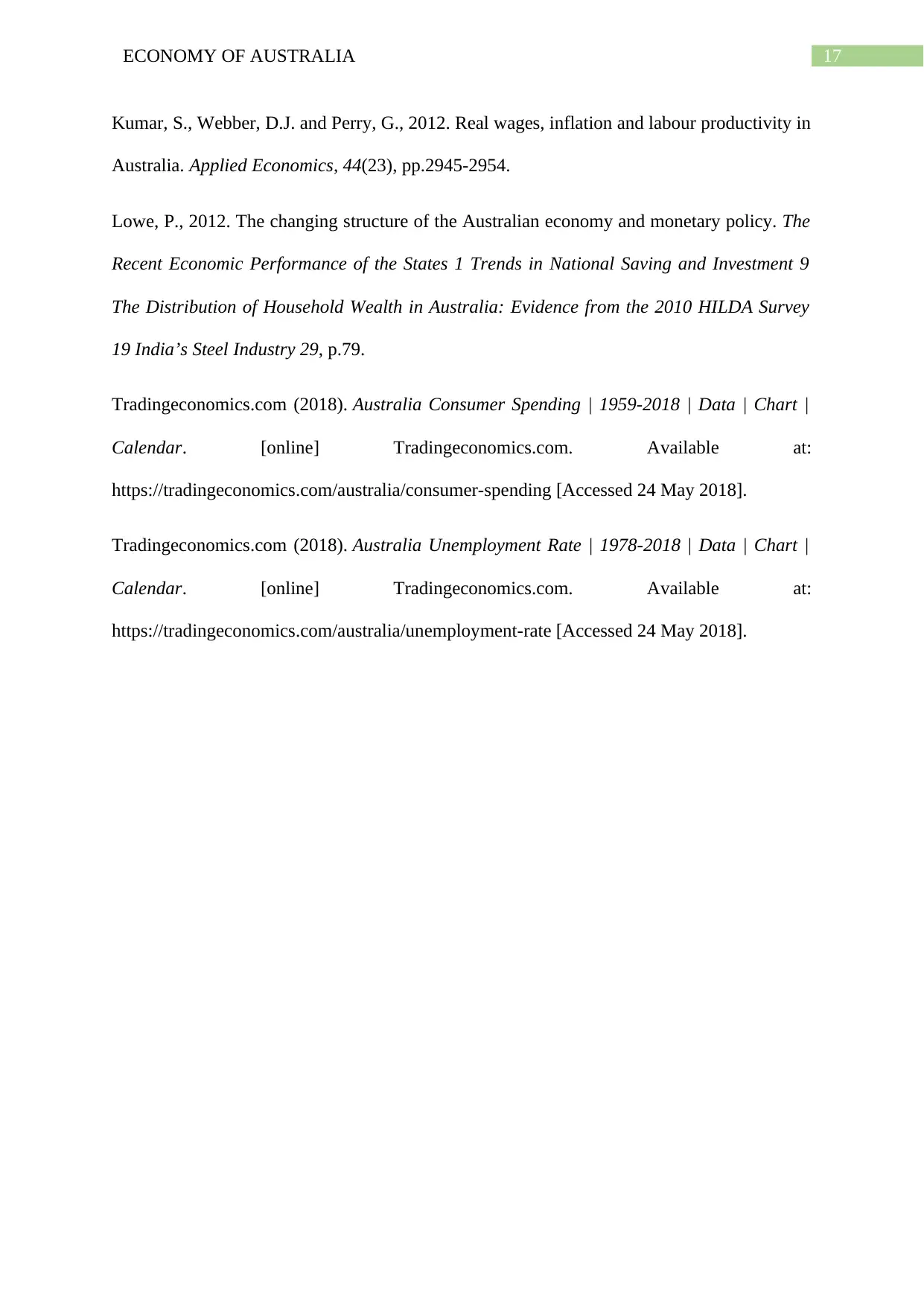
17ECONOMY OF AUSTRALIA
Kumar, S., Webber, D.J. and Perry, G., 2012. Real wages, inflation and labour productivity in
Australia. Applied Economics, 44(23), pp.2945-2954.
Lowe, P., 2012. The changing structure of the Australian economy and monetary policy. The
Recent Economic Performance of the States 1 Trends in National Saving and Investment 9
The Distribution of Household Wealth in Australia: Evidence from the 2010 HILDA Survey
19 India’s Steel Industry 29, p.79.
Tradingeconomics.com (2018). Australia Consumer Spending | 1959-2018 | Data | Chart |
Calendar. [online] Tradingeconomics.com. Available at:
https://tradingeconomics.com/australia/consumer-spending [Accessed 24 May 2018].
Tradingeconomics.com (2018). Australia Unemployment Rate | 1978-2018 | Data | Chart |
Calendar. [online] Tradingeconomics.com. Available at:
https://tradingeconomics.com/australia/unemployment-rate [Accessed 24 May 2018].
Kumar, S., Webber, D.J. and Perry, G., 2012. Real wages, inflation and labour productivity in
Australia. Applied Economics, 44(23), pp.2945-2954.
Lowe, P., 2012. The changing structure of the Australian economy and monetary policy. The
Recent Economic Performance of the States 1 Trends in National Saving and Investment 9
The Distribution of Household Wealth in Australia: Evidence from the 2010 HILDA Survey
19 India’s Steel Industry 29, p.79.
Tradingeconomics.com (2018). Australia Consumer Spending | 1959-2018 | Data | Chart |
Calendar. [online] Tradingeconomics.com. Available at:
https://tradingeconomics.com/australia/consumer-spending [Accessed 24 May 2018].
Tradingeconomics.com (2018). Australia Unemployment Rate | 1978-2018 | Data | Chart |
Calendar. [online] Tradingeconomics.com. Available at:
https://tradingeconomics.com/australia/unemployment-rate [Accessed 24 May 2018].
1 out of 18
Related Documents
Your All-in-One AI-Powered Toolkit for Academic Success.
+13062052269
info@desklib.com
Available 24*7 on WhatsApp / Email
![[object Object]](/_next/static/media/star-bottom.7253800d.svg)
Unlock your academic potential
© 2024 | Zucol Services PVT LTD | All rights reserved.




